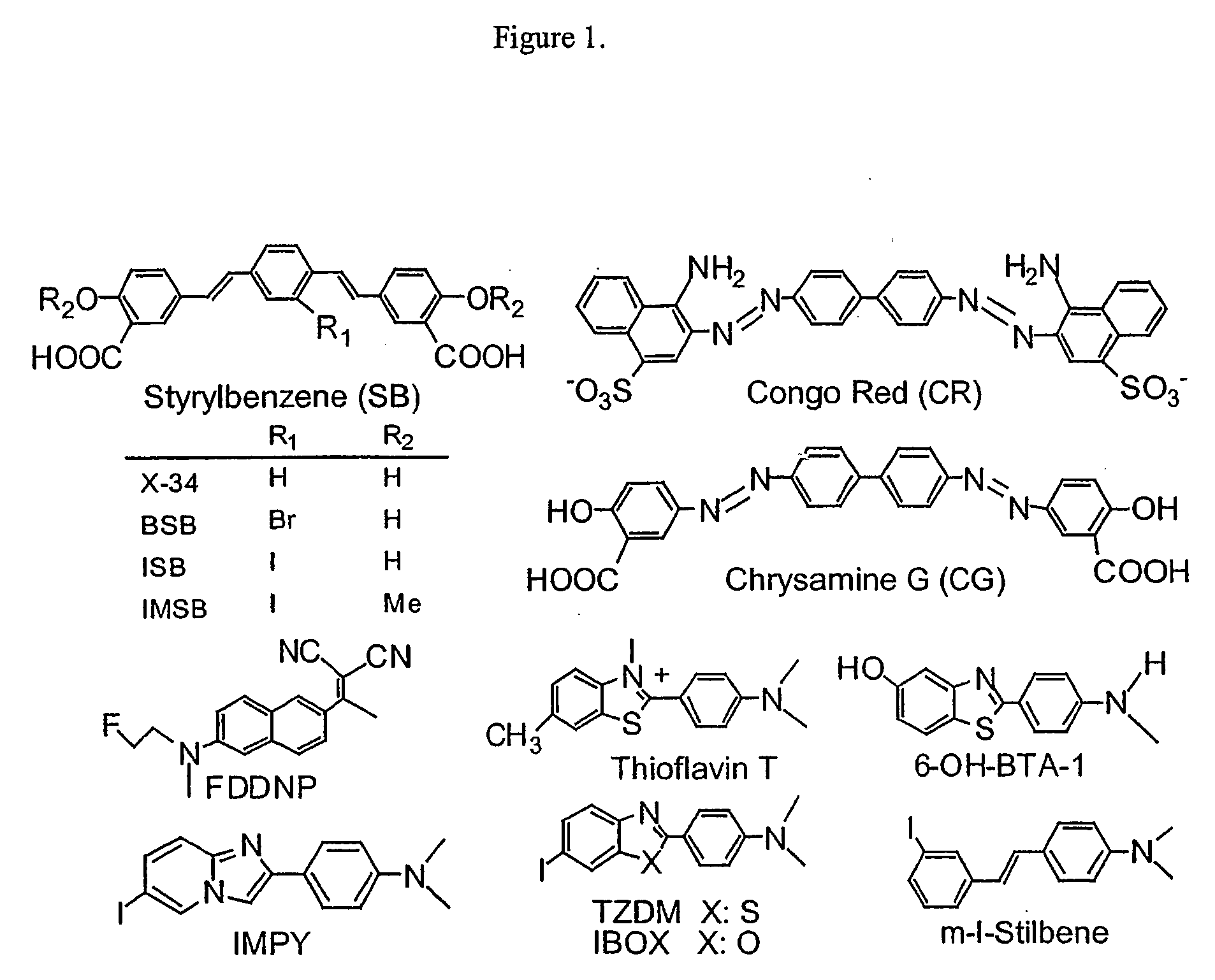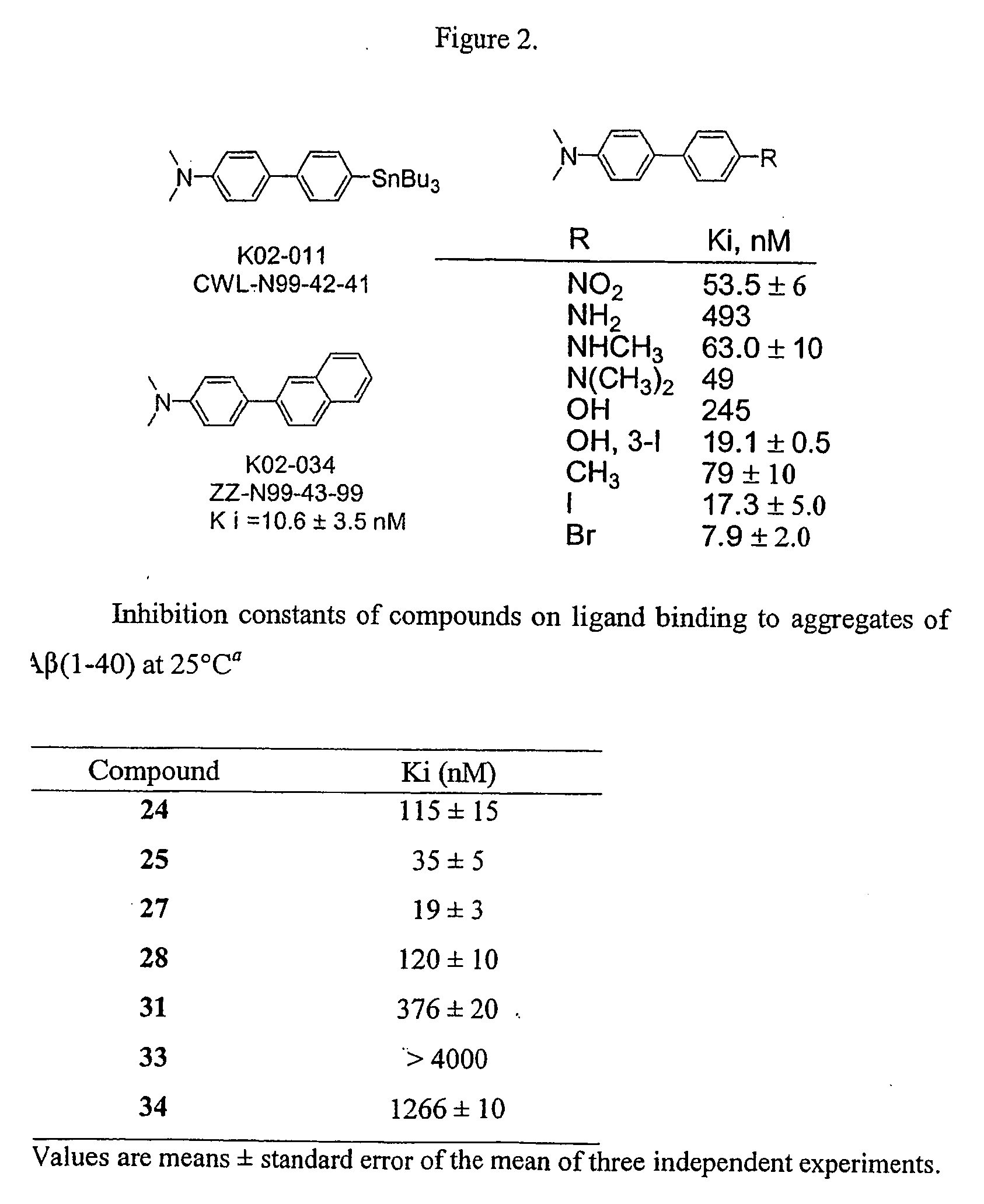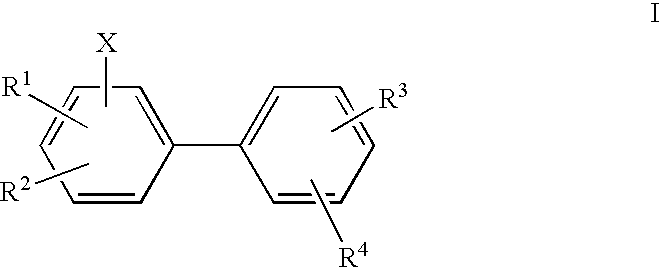Biphenyls and fluorenes as imaging agents in alzheimer's disease
a technology of biphenyls and fluorenes, applied in the field of bioactive compounds, can solve the problems of difficult direct imaging of amyloid deposits in vivo, failure to achieve computer-aided tomography, and failure to achieve amyloid deposits using magnetic resonance imaging (mri),
- Summary
- Abstract
- Description
- Claims
- Application Information
AI Technical Summary
Benefits of technology
Problems solved by technology
Method used
Image
Examples
example 1
2-(Dimethylamino)fluorene (2a)
[0272] To a stirred mixture of 2-aminofluorene (119 mg, 0.66 mmol) and papraformaldehyde (300 mg, 10 mmol) in 5 ml of AcOH at room temperature was added in one portion of NaCNBH3 (300. mg, 4.8 mmol). The resulting mixture was stirred at room temperature for 18 h, then carefully poured into 25% aq. NaOH and ice chips to make strongly alkaline (pH 11) and extracted with methylene chloride. The combined extracts were dried, filtered, and concentrated in vacuo. The residue was subjected to flash chromatography (EtOAc: Hex, 1:4). and gave 129 mg of 2-(dimethylamino)fluorene (94%). 1H NMR (200 MHz, CDCl3): δ 3.09 (s, 6H), 7.00 (d, J=7.55 Hz, 1H), 7.33-7.38 (m, 2H), 7.61-7.96 (m, 5H), 8.11 (d, J=8.40 Hz, 1H); 13C NMR (50 MHz, CDCl3): 6 45.43, 114.04, 119.74, 120.60, 120.98, 121.30, 123.99, 125.34, 126.20, 126.45, 127.40, 130.49, 134.03, 137.26, 139.08, 139.39, 151.83.
example 2
3-(Dimethylamino)fluorene (2b)
[0273] The same reaction as described above for preparing 2a was employed, and 2b was obtained in 93% from 3-aminofluorene. 1H NMR (200 MHz, CDCl3): δ 3.05 (s, 6H), 3.89 (s, 2H), 6.82 (dd, J=8.44 Hz, J=2.35 Hz, 1H), 6.99 (s, 1H), 7.18-7.25 (m, 1H), 7.36 (t, J=7.30 Hz, 1H), 7.51 (d, J=7.31 Hz, 1H), 7.68 (d, J=8.44 Hz, 2H); 13C NMR (50 MHz, CDCl3): δ 37.14, 41.04, 109.28, 111.67, 118.52, 120.43, 124.71, 124.79, 126.64, 131.12, 142.33, 142.43, 145.02, 150.33; Anal. Calcd for C15H15N: C, 86.08; H, 7.22. Found: C, 86.46; H, 6.89.
example 3
4-(Dimethylamino)fluorene (2c)
[0274] The same reaction as described above for preparing 2a was employed, and 2c was obtained in 94% from 4-aminofluorene. 1H NMR (200 MHz, CDCl3): δ 3.01 (s, 6H), 4.01 (s, 2H), 6.96 (d, J=7.78 Hz, 1H), 7.33-7.54 (m, 4H), 7.63 (d, J=6.99 Hz, 5H), 7.85 (d, J=6.96 Hz, 1H); 13C NMR (50 MHz, CDCl3): δ 36.99, 43.18, 113.26, 115.20, 119.90, 124.72, 126.62, 128.05, 133.73, 141.90, 143.20, 150.40.
PUM
| Property | Measurement | Unit |
|---|---|---|
| pH | aaaaa | aaaaa |
| temperature | aaaaa | aaaaa |
| half life | aaaaa | aaaaa |
Abstract
Description
Claims
Application Information
 Login to View More
Login to View More - R&D
- Intellectual Property
- Life Sciences
- Materials
- Tech Scout
- Unparalleled Data Quality
- Higher Quality Content
- 60% Fewer Hallucinations
Browse by: Latest US Patents, China's latest patents, Technical Efficacy Thesaurus, Application Domain, Technology Topic, Popular Technical Reports.
© 2025 PatSnap. All rights reserved.Legal|Privacy policy|Modern Slavery Act Transparency Statement|Sitemap|About US| Contact US: help@patsnap.com



